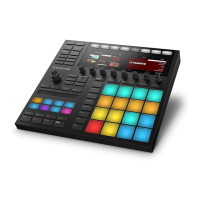(3) ARRANGER button: Press ARRANGER at any time to access the Arrange view. This view al-
lows you to edit your Sections, Scenes and Patterns to create the perfect arrangement. See the
tutorials in ↑9, Creating Scenes and ↑10, Creating an Arrangement.
(4) MIXER button: Press MIXER at any time to access an overview of your mix. Use the Mix
view to, e.g., quickly edit the level and panning of each Sound and Group. See ↑11.5, The Mix
View for more details.
(5) BROWSER button: Press the BROWSER button to access the Browser. Press SHIFT +
BROWSER (+Plug-In) to access the Plug-in menu and load a Plug-in (Internal, Native Instru-
ments, and External, as well as Instrument and Effect) in the selected Plug-in slot. You will
find many examples of using the Browser throughout the tutorials; for example, see ↑3.1,
Loading a Drum Kit from the Factory Library, ↑4.1, Opening Your Project, ↑4.2.1, Selecting
Another Snare Sample, etc.
(6) SAMPLING button: Press the SAMPLING button to access the Sample Editor. See the tutori-
al in section ↑11.4, Sampling.
(7) Page buttons: Almost any feature of MASCHINE can be accessed using the hardware con-
troller. For a clear and simple layout of the displays, the parameters are grouped into different
pages, which are selected using the Page buttons.
(8) FILE button: Press the FILE button to switch to File mode. In this mode you can quickly
save a copy of your Project, save it under another name, create a new Project, and load a
Project you have loaded recently. Press SHIFT + FILE (Save) to quickly save your modifications
to the current Project.
(9) SETTINGS button: Press the SETTINGS button to adjust the Metronome and Count-in set-
tings.
(10) AUTO button: In MASCHINE, modulation of almost any parameter on the Sound and
Group level is achieved with one-touch simplicity. Press and hold the AUTO button while turn-
ing any of the eight Knobs (or any combination) under the displays to record modulation for
the corresponding parameter(s). Have a look at section ↑7.3, Modulating Effect Parameters for
a practical example. Press SHIFT + AUTO to pin/unpin the Auto mode. When Auto mode is
pinned, you can release the AUTO button (the button stays lit) and record modulation with
both hands; this is very handy to record modulation for two (or more) parameters simultaneous-
ly! For more information on mode pinning, see ↑12.1.1, Controller Modes and Mode Pinning.
Quick Reference
MASCHINE Hardware Overview
MASCHINE - Getting Started - 191

